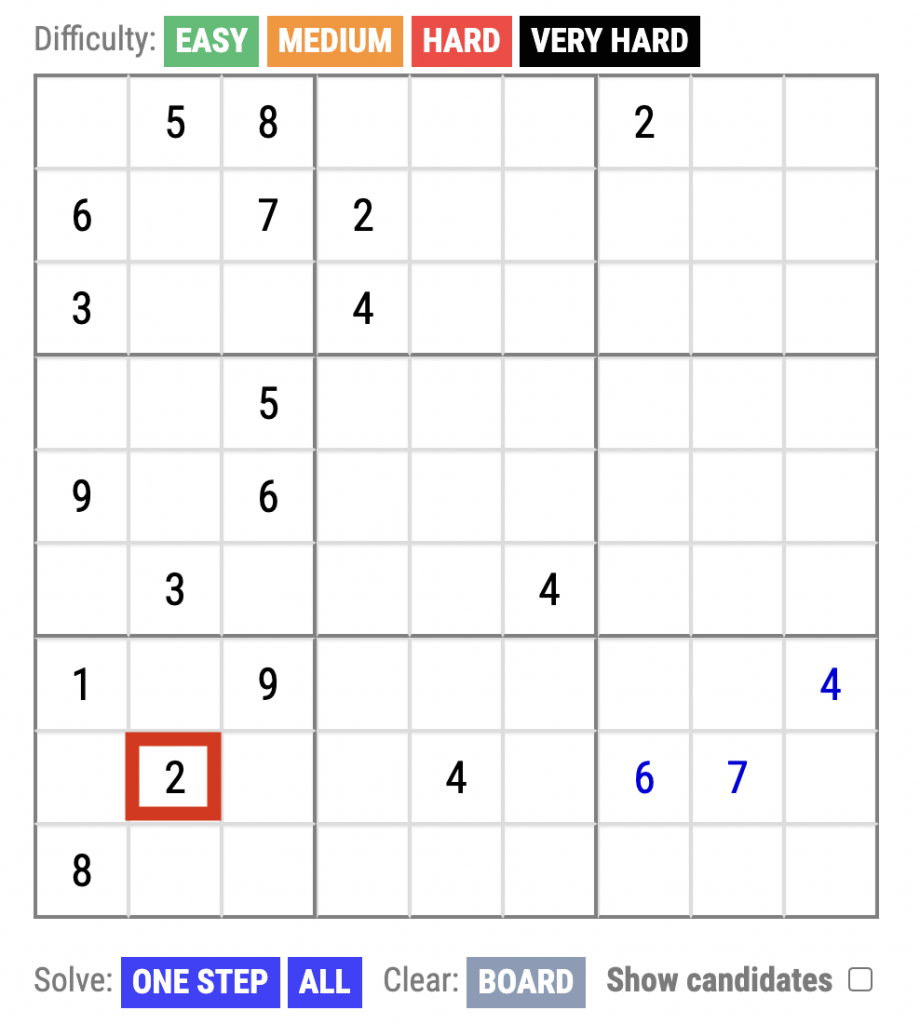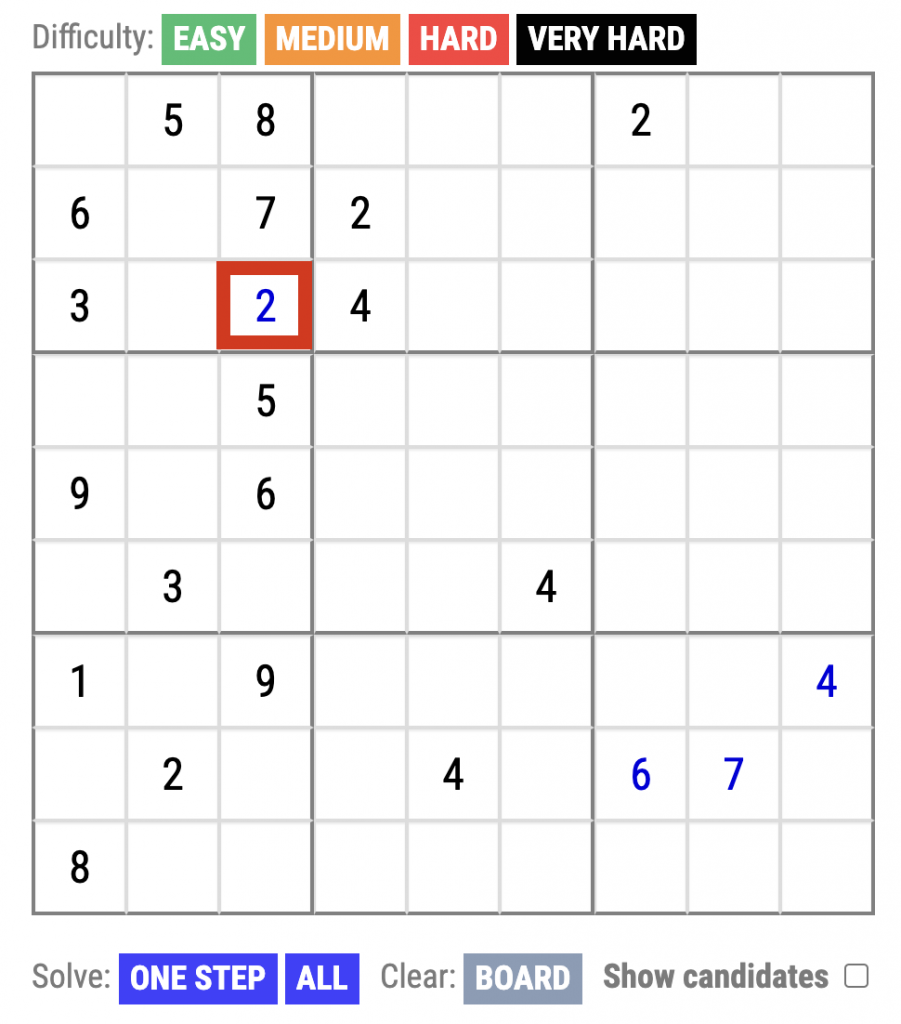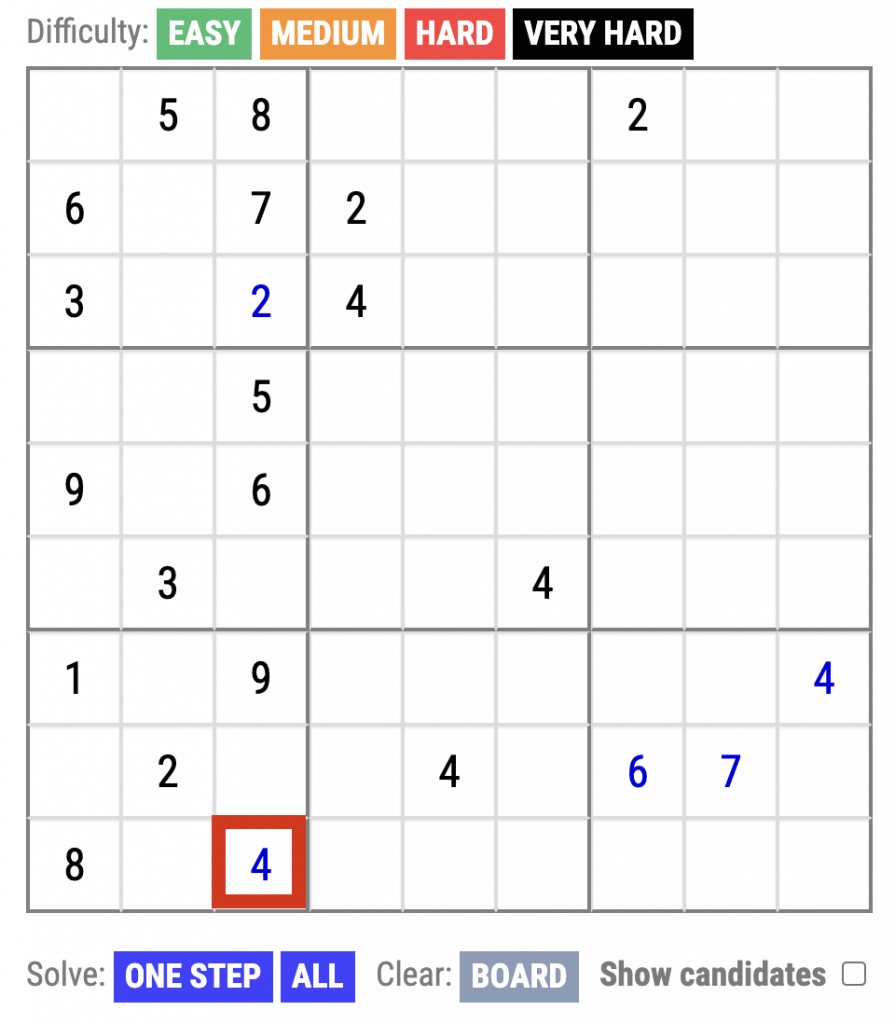This is probably the best article you can find on the internet on the subject of Sudoku. It is written with more than a decade of experience of our author, who is an honoured participant of several international Sudoku competitions.
What is sudoku?
Sudoku is a logic-based puzzle game that has gained worldwide popularity since its inception in the late 1970s. It consists of a 9×9 grid that is divided into nine 3×3 sub-grids. The game’s objective is to fill the grid with numbers from 1 to 9, making sure that each row, column, and sub-grid contains all the digits from 1 to 9 without repetition.
At the beginning of the game, some of the squares in the grid are already filled with numbers, and the player’s task is to fill in the remaining empty squares to complete the puzzle. The game’s difficulty level depends on the number of pre-filled squares and the complexity of the pattern.
Sudoku puzzles can be found in newspapers, magazines, and books, and there are also numerous websites and mobile apps dedicated to the game. Sudoku is popular because it is a challenging mental exercise that requires concentration, logical reasoning, and problem-solving skills. It’s also a great way to pass the time and can be enjoyed by people of all ages.
Sudoku has even been found to have some cognitive benefits, such as improving memory and reducing the risk of cognitive decline. It’s a fun and challenging game that can provide hours of entertainment and mental stimulation.

History of Sudoku
The history of Sudoku can be traced back to the late 19th century, when a French newspaper called “La France” published a puzzle called “Number Place.” The puzzle was similar to Sudoku, but it was played on a 9×9 grid with numbers ranging from 1 to 9, and it did not have the sub-grids that are characteristic of Sudoku today.
In the 1970s, a retired architect from Indianapolis named Howard Garns created a puzzle called “Number Place” that was later renamed “Sudoku” by a Japanese puzzle publisher in the 1980s. The puzzle gained popularity in Japan, and by the 1990s, it had spread throughout Asia and Europe.
In 2004, The Times, a British newspaper, began publishing Sudoku puzzles, which quickly became popular around the world. The popularity of Sudoku grew rapidly, and it became a cultural phenomenon, with books, magazines, and newspapers dedicated to the game.
Today, Sudoku is played by millions of people worldwide and has become a staple of puzzle books, newspapers, and magazines. The game has also evolved, with variations such as “Samurai Sudoku” and “Killer Sudoku” that add additional challenges to the traditional puzzle.
Despite its relatively short history, Sudoku has become one of the most popular puzzle games in the world, with its simple rules and challenging gameplay capturing the hearts and minds of puzzle enthusiasts everywhere.
How to Play Sudoku
If you want to learn how to solve Sudoku but do not know how to play, this guide will provide you with the basic rules and principles of the game.
1. Learn the Game Board

The Sudoku puzzle consists of a 9×9 grid of squares that are divided into 3×3 sectors. The objective is to fill each of the 81 cells with a single number, from 1 to 9, so that no number is repeated in any row, column, or sector.
2. Mastering the Rules of Sudoku
To solve Sudoku, you need to follow a set of simple rules:
- Each of the 81 cells can only contain a single number.
- The numbers 1 to 9 must be used to complete the Sudoku table.
- Each 3×3 sector must contain numbers from 1 to 9 without repetition.
- Each vertical column should contain numbers from 1 to 9 without repetition.
- Each horizontal row should contain numbers from 1 to 9 without repetition.
Once you’ve solved the puzzle, every row, column, and 3×3 sector will contain all numbers from 1 to 9 without repetition. In other words, no number can repeat in any row, column, or sector.
3. Identifying Cells with a Single Number
When starting a new game, some cells are already filled with numbers, and based on those numbers, you can identify other cells that can only have one number. As you fill in the squares with only one possible number, you can use the solved numbers to identify the other numbers in the remaining cells.
For example, in the image below, only the number 2 can fit in the square with coordinates R8C2.

This is because numbers 1, 8, and 9 already exist in the same 3×3 sector, while numbers 3 and 5 are already in the same column as the highlighted square. Numbers 4, 6, and 7 are also in the same row as the highlighted square. Thus, the only remaining number that can fit in this square is the number 2.
4. Using Solved Numbers to Fill Other Squares
As you fill in squares with only one possible number, you’ll be adding new numbers to the grid that will help you identify the other numbers in the remaining squares. For example, adding the number 2 to cell R8C2 in step 3 allows you to determine that the cell R3C3 highlighted below should also contain the number 2.

This is because having 2 in R8C2 (from step 3) rules out finding 2 in the middle column of C2. Similarly, two twos in rows R1 and R2 exclude the possibility of having twos in the first two rows of the upper-left 3×3 sector. Therefore, the only remaining cell that can contain the number 2 is R3C3.
Note that not every time you add a new number to the grid, a new cell will be “opened” or “solved.” The more complex the puzzle, the more numbers you’ll have to solve to figure out which numbers should be in the other squares.
5. Using Pencil Notes
However, you may reach a point where you can no longer identify the possible numbers for each cell unambiguously while solving simple Sudoku puzzles. In that case, you should use the “pencil notes” technique to mark all the possible candidate numbers for each cell based on the available information. Instead of adding all possible numbers to each empty cell, it’s better to focus on certain cells and numbers one by one. The more complex the puzzle, the more numbers you’ll have to solve to figure out which numbers should be in the other squares.

Looking closely at the possible arrangements of the digit 4 in this sudoku, you will notice that only one cell in column C3 can contain this digit. As we know that each column in Sudoku must contain only one digit 4, and cell R9C3 is the only cell in the third column that can contain the digit 4, then using logic (lines R8 and R6 of column C3 cannot contain the digit 4), we conclude that the digit 4 must stand in this cell.

6. Repeat the previous steps until you have solved the puzzle
Having read up to this stage, it is safe to say that you have now mastered the skill of Sudoku solving. You need to repeat the above steps to complete all the cells in the table. Solving more complex Sudoku puzzles often requires the use of advanced techniques, but at this point you can improve your practical skills by solving simple and intermediate level puzzles. Now that you know how to play Sudoku, take a look at our list of Sudoku tips to improve your speed.
Sudoku varieties
Sudoku is a puzzle game that requires players to fill a 9×9 grid with numbers from 1 to 9. The game’s objective is to ensure that each row, column, and sub-grid contains all nine digits without repetition. While Sudoku can seem intimidating at first, mastering the rules of the game is relatively simple.
- Understand the Grid: The Sudoku grid is made up of nine columns and nine rows that intersect to create nine 3×3 sub-grids. Each square in the grid can hold one digit from 1 to 9. Some squares are already filled in, and your job is to fill in the empty squares.
- Remember the Rule of Nine: Each row, column, and sub-grid must contain all nine digits without repetition. This means that each row must have one of each number from 1 to 9, each column must have one of each number from 1 to 9, and each sub-grid must have one of each number from 1 to 9.
- Use Logic: Sudoku is a logic-based game, and there is always a solution that can be reached by logical deduction. Start by looking for the numbers that are missing from each row, column, and sub-grid. Once you have identified the missing numbers, start filling them in based on the numbers that are already in the grid.
- Use Pencil Marks: One useful technique is to use pencil marks to keep track of the possible numbers for each square. You can write the numbers 1-9 in small font in the corner of each square. This will help you keep track of the numbers that are still missing from each row, column, and sub-grid.
- Use Elimination: Another useful technique is to use elimination. Look at each row, column, and sub-grid to see which numbers are already filled in. Use this information to eliminate the numbers that can’t go in certain squares. For example, if you see that the number 2 is already in a row, you know that it can’t go in any of the other squares in that row.
- Work One Square at a Time: Don’t try to solve the entire puzzle at once. Instead, focus on one square at a time. Start with the squares that only have one possible number, then move on to the ones that have two or three possible numbers.
- Keep Practicing: The more you play Sudoku, the better you will become. Don’t get discouraged if you can’t solve a puzzle at first. Keep practicing, and you will soon be able to solve even the most challenging puzzles.
By mastering the rules of Sudoku, you can enjoy this fun and challenging game for hours. With practice, you can become an expert Sudoku player and solve even the most difficult puzzles with ease.
Interesting facts about Sudoku
Sure, here are some interesting facts about Sudoku:
- The name “Sudoku” comes from Japan and means “single number.” It was invented by Howard Garns, an American architect, and was later popularized in Japan by Nikoli, a puzzle company.
- The first Sudoku puzzle was published in 1979 in Dell Magazines under the name “Number Place.” It was introduced to Japan in 1984 and gained popularity in the 1990s.
- There are more than 5 billion possible Sudoku puzzles, but only a fraction of them are valid puzzles that have a unique solution.
- Sudoku is a type of Latin square, which is a mathematical concept that involves arranging numbers or symbols in a grid so that no row or column contains a repeated element.
- Sudoku puzzles have been used to test the problem-solving abilities of artificial intelligence systems, and they have been used in scientific research to study problem-solving strategies in humans.
- In 2012, a team of mathematicians from the University of London developed an algorithm that can solve any Sudoku puzzle in less than a second.
- The world record for solving a standard 9×9 Sudoku puzzle is 1 minute and 23.93 seconds, set by Thomas Snyder of the United States in 2018.
- There are variations of Sudoku puzzles, such as Samurai Sudoku, which consists of five overlapping 9×9 grids, and Jigsaw Sudoku, where the grid is divided into irregular shapes instead of 3×3 boxes.
- Sudoku has become so popular that it has inspired numerous variations, including Sudoku puzzles with letters, colors, and shapes instead of numbers.
- The popularity of Sudoku has led to the creation of Sudoku tournaments and competitions, and there are even professional Sudoku players who make a living by solving puzzles and competing in tournaments.
International Sudoku tournaments
International Sudoku tournaments are organized annually for Sudoku enthusiasts from all around the world. These tournaments are a great opportunity for people to compete against each other in a fun and challenging way.
One of the most popular international Sudoku tournaments is the World Sudoku Championship (WSC), which has been held annually since 2006. The WSC brings together the best Sudoku players from around the world to compete for the title of World Sudoku Champion. The tournament features a variety of Sudoku puzzles, including traditional Sudoku, Sudoku variants, and other types of logic puzzles.
Another major international Sudoku tournament is the Sudoku Grand Prix, which is organized by the World Puzzle Federation (WPF). This tournament consists of a series of online puzzle contests that take place throughout the year. The top performers in these contests earn points that go towards their overall ranking in the tournament.
In addition to these major tournaments, there are also many smaller Sudoku tournaments that take place around the world. These tournaments may be organized by local puzzle clubs or other organizations, and they offer Sudoku enthusiasts a chance to compete against each other in a more casual setting.
Overall, international Sudoku tournaments are a great way for people to connect with others who share their passion for puzzles and logic games. They offer a challenging and exciting experience for both casual Sudoku players and serious competitors alike.
Sudoku for free
There are many places where you can play Sudoku for free. Here are a few options:
Online sudoku sites
There are many sites that offer free sudoku puzzles. These sites offer puzzles of varying levels of difficulty, and some even allow you to compete against other players. Our site https://dailysudokupuzzles.com/ is rightly considered one of the best – many professionals use it in preparation for competitions.
Mobile apps Sudoku
There are many Sudoku apps for iOS and Android that can be downloaded for free. These apps offer different puzzles and difficulty levels as well as other features such as hints, autocheck and progress tracking.
Printouts
If you prefer to solve sudoku puzzles on paper, there are many websites offering free printable puzzles that you can download and print out. These sites offer puzzles of various sizes and levels of difficulty. You can print sudoku at https://dailysudokupuzzles.com/
Newspapers and magazines
Many newspapers publish sudoku puzzles in their daily or weekly issues. Although you may have to buy a newspaper to access the puzzle, it’s a great way to solve sudoku puzzles offline and in a traditional format.
All in all, there are plenty of free sudoku game options, whether you prefer solving puzzles online, on your mobile device or on paper. Keep up with your progress and take every opportunity to improve your level.


Hmm… My typical Sudoku solving times fall within the range of 15-25 minutes for Expert puzzles and 10-20 minutes for Evil puzzles. While I tend to encounter a roadblock in solving an Expert puzzle about 20% of the time, I seldom face any significant challenge while solving an Evil puzzle.
I have often wondered if the Evil puzzles are generated differently from the rest, given their higher level of complexity. It’s intriguing that there is no indication of how many people were able to solve them, which leads me to question if they are too new for rating or if there is a distinct curation process for the Evil ones, unlike the others.
Well, this is a very decent result for most sites. On our site, VERY HARD mode is very different from HARD mode – there will definitely be no problem with complexity)
I highly recommend to try it – share your impressions later.